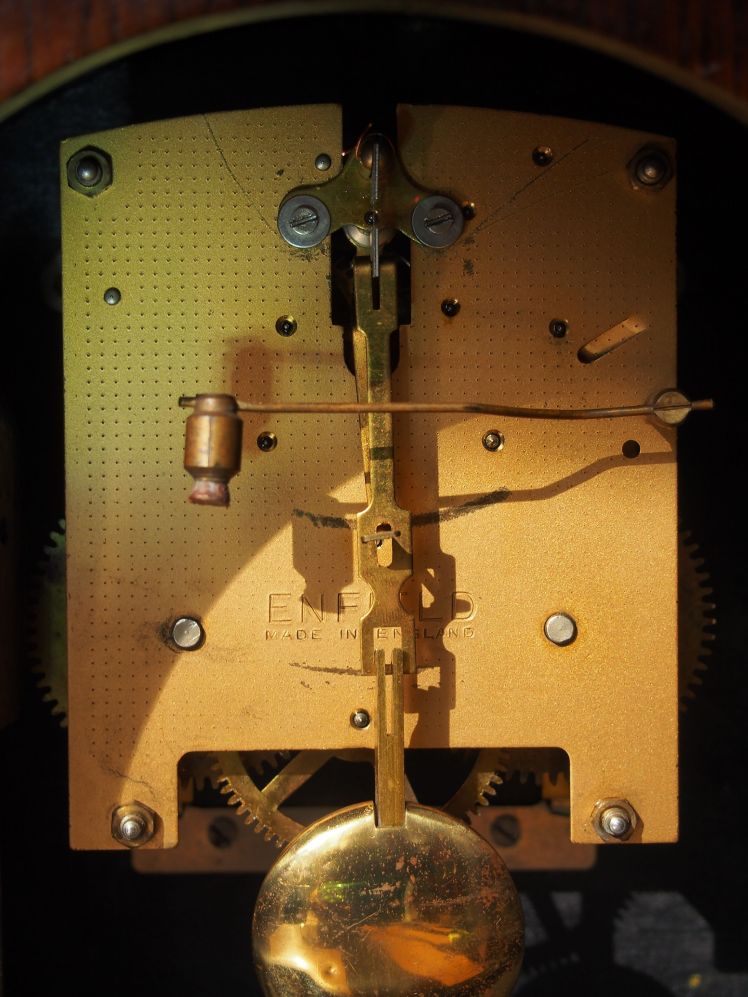When I picked up this clock I realized that the person who worked on it was really just a tinkerer but it was attractive and the strike sounded great.

I brought it home and knew that I had to learn a lot more about clock repair because it would occasionally stop for no apparent reason and it was difficult to keep in beat. It had to be serviced. With two trains it should be fairly simple to work on so, I went about cleaning and servicing the movement.

Two pivot holes on the back plate were a little worn but not enough to cause any issues at this time. However, since I know very little about bushing work at this point I think it wise to put off repairs until I know how to do the work. A bushing machine is on the horizon but limited funds do not permit me tackle those more in-depth repairs just yet. Anyway, back to the movement.
While reassembling the strike side the mainspring unhooked. Not sure why. I was prepared to disassemble the movement to reattach the mainspring but a little wiggling corrected the problem. Once the parts were cleaned in an ultrasonic cleaner and the parts were dried, the movement was assembled and oiled. There are two adjusting two screws on either side of the verge that determine the correct height between the pallets and the escape wheel. Through trail and error I was able to get a good pendulum swing and a steady beat.

I decided not to re-attach the 2 clips just yet since it would not take much to break them. Only after the clock has been running reliably and striking correctly will I reattach the clips. Not a good design in my view and I wonder if these clocks were ever meant to be worked on after they left the factory.

Trouble with the click
The Enfield Clock Company history
The Enfield Clock Company (London) Ltd was formed in 1929. The first clocks were sold in 1932.
The company used modern assembly line techniques to manufacture and assemble their clock movements, based on the American system of automated factories. The clocks were originally sold for wholesale and export only with movements sold to shops, casing them up themselves. The Enfield Clock Company prided themselves in the ‘British made’ clock. Gongs were supplied by Wagner in Whitechapel, Dials from Beta Manufacturers. By 1932, they started making their own bezels and had their own chrome plating Shop. In 1933, the company was finding it difficult to compete on price so the company was sold to Smiths Industries. This led to the name ‘Smiths Enfield’ clocks. Before the sale, the Enfield plant had a very tight budget, and had to sell all the movements made each week to cover wages and other expenses (they had a staff of 140).
In 1935 they started to produce grandfather movements driven by 3 chrome cased weights, 30cm dials with chrome trim. They later produced Grandmother chime movements and strike wall regulator movements.
1935/6 they introduced a striking 14 day clock in a Jacobean Oak case so putting the company on a more established footing. About this time the Enfield Strike range was established as well as the De Luxe range of Westminster chimes known as the ‘Enfield Royal’ named after the Royal Dukes. These clocks had a 5 year Guarantee and were better finished with damascened plates and chromed pendulum bob and gong rods. The underslung rods allowed for a slimmer case.
1939, and the outbreak of war, the factory was turned over to war time production. Clock production did not stop completely but material shortages were a major problem. The main production of the factory was fuses and flame markers etc for the armed forces.
After war, American machines were allowed to be kept and production of the 53mm movement re-commenced. Production was later moved to Smiths factory at Cricklewood and then later to their Welsh factory about 1955. Under Smiths industries the production line was changed to watches. Ultimately all clock production was phased out and so ended the company shortly thereafter.
I believe this clock was made around 1950. It certainly reflects the utilitarian post-war designs of the period.
This is the first step in the restoration and repair of this time and strike mantel clock and as I learn more about clock repair I will certainly share my experiences.

Really informative and good structure of subject matter, now that’s user pleasant (:.
LikeLike